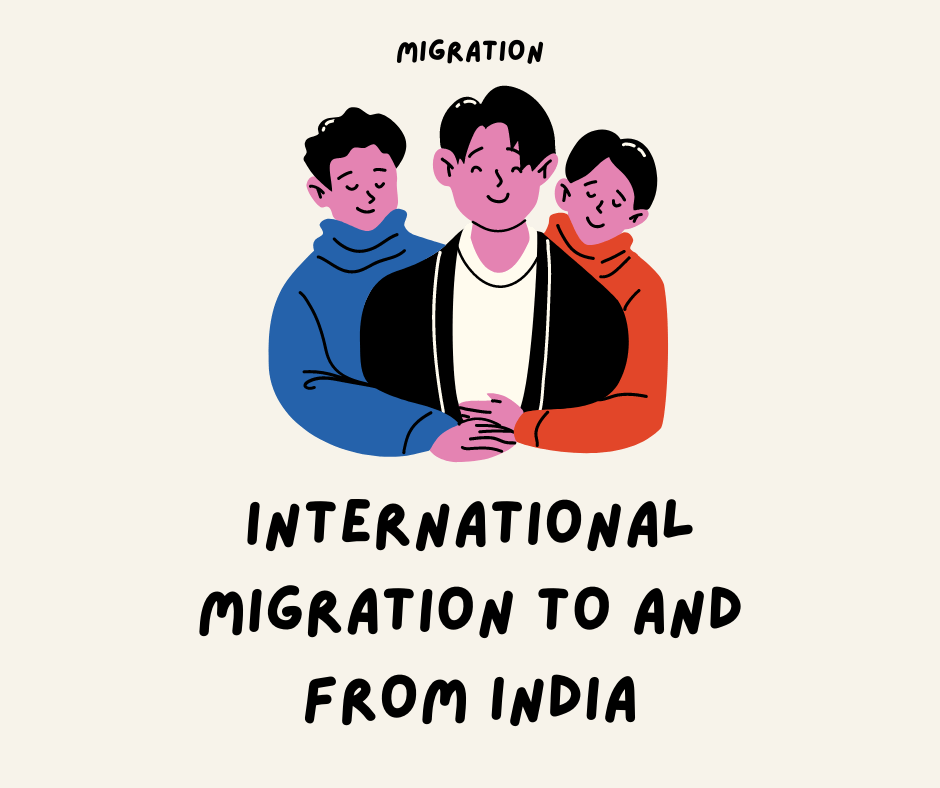International migration to and from India
Immigration
Indian history is filled with episodes of foreigners coming to our country and settling here (mostly from Central and West Asia and also from Southeast Asia).
But even in contemporary terms, this trend has continued:
- As per Census 2001, around 5 million people have migrated to India from other countries.
- In recent times, most of the immigrants (legal and illegal) have come from our neighbouring countries – almost 96 per cent of the immigrants are in fact from our neighbouring countries, such as Bangladesh (3.0 million) followed by Pakistan (0.9 million) and Nepal (0.5 million).
- Among the immigrants are some refugees too (due to political, religious reasons etc.), e.g. from Tibet, Sri Lanka, Bangladesh, Pakistan, Afghanistan, Iran, and Myanmar.
Emigration and Indian Diaspora
In ancient times, emigration from India was restricted due to cultural and religious reasons. But even then, a few people went abroad and spread ideas of Hinduism and Buddhism.
However, mass emigration of Indians started a bit later, during the British period.
Most of the emigration from India nowadays is for economic reasons, such as better job opportunities, higher studies, business, etc. Most of it is directed towards Middle-East, Western Europe, America, Australia and East and South East Asia.
As per a general estimate, around 20 million Indians live abroad (Indian Diaspora). They are spread in over 110 countries.
Let’s see the various phases of emigration of Indians in the recent centuries.
Phase 1 of Emigration
Most of the emigration during this period was in the nature of forced labour, if not slaves. British empire was spread all over the world and they needed workers. India, with its huge population, provided them a suitable source.
Millions of Indian indentured labourers were sent to:
- Caribbean islands (Trinidad, Tobago and Guyana) by the British (mostly from UP and Bihar)
- Fiji and Mauritius by the British (mostly from UP and Bihar)
- South Africa by the British (mostly from UP and Bihar)
- Reunion Island, Guadeloupe, Martinique and Surinam by French and Dutch.
- Angola, and Mozambique (as plantation workers) by Portuguese (mostly from Goa, and Daman and Diu)
Most of these emigrations were for a limited period under the Girmit Act (Indian Emigration Act). However, the conditions of Indian labourers were about the same as that of slaves. A lot of them were never allowed to come back, while some decided to settle in the new places after spending decades of their life there.
Phase 2 of Emigration
This phase of emigration was that of semi-skilled and skilled labours looking for greener pastures.
- Many professionals, artisans, traders and factory workers went to nearby countries (Thailand, Malaysia, Singapore, Indonesia, Brunei and African countries, etc.) for better economic opportunities.
- Many Indians emigrated to the West Asia (Arab countries) during the oil boom in the 1970s.
- Many entrepreneurs, storeowners, professionals, and businessmen even emigrated to Western countries in search of a better life (USA, Europe, Australia, etc.)
Phase 3 of Emigration
This phase of emigration from India was that of highly trained and skillful Indian professionals, such as:
- doctors, and engineers – they started emigrating from 1960s onwards.
- software engineers, management consultants, financial experts, media persons – they started emigrating from 1980s onwards.
There was a lot of red-tapism in India, the growth rate was slow, private jobs were limited and entrepreneurship was not encouraged much. All these push factors, along with the pull factors from more developed countries such as USA, Canada, UK, Australia, New Zealand and Germany, etc., led to many skilled Indians leaving the country and utilizing their capacity in the growth of foreign countries. There was a lot of debate during 1980s to 2010s regarding ‘Brain Drain’ from India.
However, later our policy makers started seeing the positives of this emigration:
- Some Indians came back to the country with latest technology and know-how, which helped in the growth of India.
- A strong Indian diaspora developed in almost all the major countries. And the hard-working, intelligent, smart, and well-mannered approach of Indians (in general) made a good image of India. It boosted India’s soft power.
Now, Indian diaspora is considered one of the strongest, powerful, and most successful communities in the world. They are in general highly educated, the highest earning and prospering groups.
This gained momentum in the 1990s when most of the Indians emigrating from India were highly educated – it was a knowledge-based emigration.
Now, the world has a good stereotype for Indians – people who like music, and dance, are good in Maths, Science and in any intellectual field in general.
